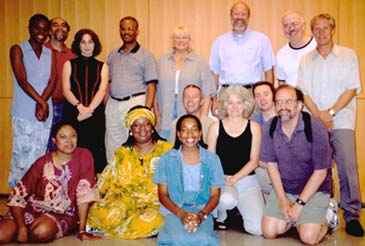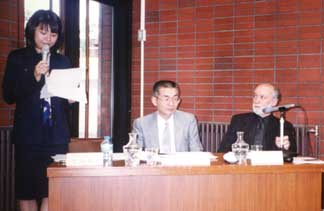September 2002
September 11 Digital Archive Collects 30,000 Contributions

Did you send an email to a friend or family member on September 11th? In the hours and days following the attacks, more than 100 million Americans did. As with so many materials registering the social and cultural experiences of ordinary Americans in the past, however, this ephemeral digital record might slip away from us, even after the passage of only a year. Responding to that possibility, ASHP/CML and the Center for History and New Media at George Mason University created the September 11 Digital Archive (https://911digitalarchive.org/), a permanent digital repository about the attacks and the public reaction to them. Since its March launch, the Archive has accessioned a diverse collection of over 30,000 contributions, ranging from chat room discussions to interviews with Arab-Americans. In turn, the Archive’s website – which presents a significant fraction of the project’s collection–routinely receives two and half million visits a week, making it one of the most embraced noncommercial locations on the Internet. The project’s staff hopes to cast their archival nets broadly by employing new digital tools, creating a record that will allow the history of the attacks and their aftermath to be told “from the bottom up.”

Collaborating closely with national and local institutions—including the Smithsonian Institution’s National Museum of American History and National Public Radio—the Archive has become the repository of choice for the vast digital record precipitated by September 11th. The Archive’s collection has received extensive national and international media coverage, including reports by CNN, New York One, The New York Times, The Wall Street Journal, El Diario, Mexico’s Univista Television, and 218 local newspapers.
Perhaps some of the most compelling material in the Archive’s holdings are the computer animations and digitally manipulated imagery Americans crafted on their home computers in the wake of 9/11. The project’s director, Fritz Umbach, describes these expressions of public sentiment as digital folk art. “They really do fit all the classic criteria for folk art,” Umbach reports, “they were created for non-commercial reasons, and distributed by non-commercial means. And in many ways, these creations encapsulate the rawness and immediacy of the public reaction.”
Report on the Learning to Look National Leadership Institute
In July ASHP/CML launched the latest phase of its influential teaching-with-technology faculty development program, the New Media Classroom. Funded by NEH, “Learning to Look: Visual Evidence and the U.S. Past in the New Media Classroom” started as a one-week institute at the CUNY Graduate Center involving the directors of ten affiliated “regional centers” from Washington state to Massachusetts for hands-on study, application, and reflection on critical use of online archival images in teaching history and related humanities courses. Noted scholars of U.S. history and American Studies also took part, updating participants on ways visual resources reveal information about different historical eras and themes. The year-long program features such activities as surveying and evaluating image archives found on the World Wide Web and CD-ROMs; building collaborations between art and cultural institutions; and preparation of curricular models that use visual sources to enhance student understanding of the past. In summer 2003, each Regional Center will coordinate a one-week institute based on the national model. For more information on Learning to Look, go to: https://web.archive.org/web/20110808184714/http://web.gc.cuny.edu/ashp/L..., or contact: Donna Thompson: DThompson@gc.cuny.edu.

ASHP/CML Materials Adapted for ESL Students
In the past few years, master teachers of our NYC Making Connections program have been working with ASHP/CML educators to adapt some of our resources for ESL students. Based on four video documentaries, an ESL curriculum packet for secondary school humanities classrooms will be available in the fall. The packet includes adaptations of four video viewers’ guides: Daughters of Freemen, Five Points, 1877: The Grand Army of Starvation, and Up South. In addition, instructional techniques for advancing students’ literacy skills were developed on a range of topics covered in the videos including, immigration/migration, labor, industrialization, urban life, and race.
New book from ASHP/CML Executive Director
ASHP/CML Executive Director Joshua Brown’s social history of the nineteenth-century U.S. illustrated press, Beyond the Lines: Pictorial Reporting, Everyday Life, and the Crisis of Gilded Age America, was published by University of California Press in August.
The book will also be released in electronic format as part of the American Council of Learned Societies’ History E-Book Project.
ASHP/CML Goes to Japan


Labor at the Crossroads Programs Reach New Audiences
Salt Peanuts, a five-minute video originally produced as part of ASHP/CML’s Labor at the Crossroads cable television series, will be broadcast on the Free Speech Television Network, which reaches more than six million US homes. In addition to the broadcast of Salt Peanuts, Free Speech TV will air ten of our best titles in the next year. For broadcast information please visit www.freespeech.org.
Salt Peanuts reveals the impact of 9/11 on airline workers, juxtaposing an interview with former US Air flight attendant Joshua Freeze (AFA) with a dramatization concerning government airline bailouts. The program was screened at the Museum of Modern Art and at the Art In General Gallery, both in New York City, in 2001 and is also available via the Internet on the September 11 Digital Archive website at www.911digitalarchive.org/special/.
In other Labor at the Crossroads news, ten of the latest Labor at the Crossroads programs have been purchased by labor unions in Austin, Texas, for broadcast on their local public access station. And we are happy to report that Labor X recently received a $4,000 grant from the North Star Fund for general operations.
Calendar: Picturing a Nation: Teaching with American Art and Material Culture
October 4-5, 2002
National Council for History Education
Discovering History Conference
Saratoga Springs, NY
ASHP/CML will present with the Brooklyn Museum of Art a report on a collaborative curriculum development and teacher training program funded by the National Endowment for the Arts. Using the museum’s American paintings and decorative arts collection and ASHP/CML materials, the project focused on the development of interdisciplinary classroom lessons for use in secondary school humanities classrooms. Participants will gain insight into innovative teaching strategies that integrate a critical approach to primary source analysis. The resource guide will be sold at the conference. For more information about the conference see: www.history.org/nche.
Calendar: “September 11: One Year After” an Interdisciplinary Conference
October 19, 2002, 9AM-5PM
The Museum of the City of New York
The September 11 Digital Archive, in partnership with the New York Metro American Studies Association, presents an interdisciplinary conference to mark the anniversary of September 11, 2001. Through panels, roundtables, and online components, the conference will address such topics as: Teaching 9/11 in the Classroom; Archiving, Memorializing, and Representing September 11; Patriotism, Irony, and Heroism Reconsidered; Civil Liberties, Immigration, and Racial Profiling; and Architectural and City Planning Concerns. For more information, please visit: www.911digitalarchive.org/nymasa-conf.
Calendar: The Middle East in the American Mind
Monday, October 28, 2002, 6-8PM
CUNY Graduate Center, Room 9206
The Center for Media and Learning and the Middle East and Middle Eastern American Center host a conversation among scholars to explore the ways that Americans do—and do not—understand the cultures, histories, and politics of the region defined as the Middle East. What role do cultural productions play in shaping American understandings of the Middle East? What about Americans’ claims to natural resources there and perceptions of the region as the birthplace of three major religions? How has the growth of the Middle Eastern diaspora in the U.S. and the ways that Middle Eastern immigrants and Americans of Middle Eastern descent have negotiated their dual national identities shaped American perceptions of the Middle East?
Participants include:
Melani McAllister, Assistant Professor of American Studies at The George Washington University and the author of Epic Encounters: Culture, Media, and U.S. Interests in the Middle East, 1945-2000.
Ammiel Alcalay is Professor of Classical, Middle Eastern, and Asian Languages at Queens College, CUNY, and author of After Jews and Arabs: Remaking Levantine Culture and Memories of Our Future.
Moustafa Bayoumi (Moderator), Associate Professor of Comparative Literature at Brooklyn College, CUNY, and co-editor of The Edward Said Reader.
This program is part of the 2002 State Humanities Month, a celebration sponsored each October by the New York Council for the Humanities.
Calendar: “Talking History”: On-line Forums from History Matters
Fall 2002
https://historymatters.gmu.edu/browse/talkhist/
September 2002 — Feminist Movements in U.S. History with Estelle Freedman (Stanford University) as Guest Moderator
October 2002 — Using Material Culture to Teach U.S. History with Laurel Thatcher Ulrich (Harvard University) as Guest Moderator
November 2002 — History of Early Settlement in the U.S. with Alan Taylor (University of California, Davis) as Guest Moderator
The discussions will focus on teaching these topics in the standard U.S. history survey course and suggestions for resources or strategies. Although the moderators will respond to questions and comments, we also hope that participants will respond to one another and continue the discussion after the guest moderator’s month.
Calendar: Learning to Look: Visual Evidence and the U.S. Past in the New Media Classroom at CUNY
Friday, October 4, 2002, 10AM to 1PM
Graduate Center
Friday, November 15, 2002, 10AM to 1PM
Hostos Community College
Participate in an interdisciplinary dialogue about the “best practices” for integrating visual evidence, new media resources, and active learning pedagogy into classrooms where U.S. history and culture are taught.
Contact: DThompson@gc.cuny.edu
